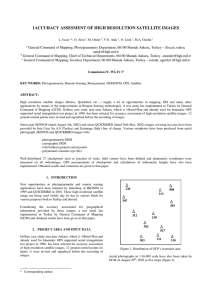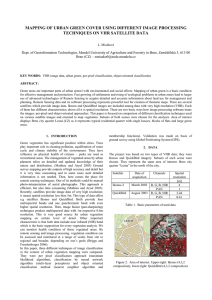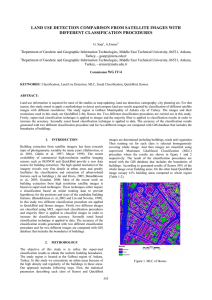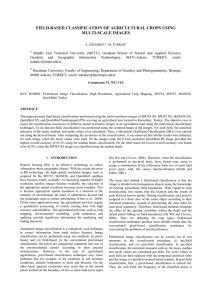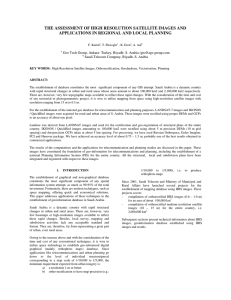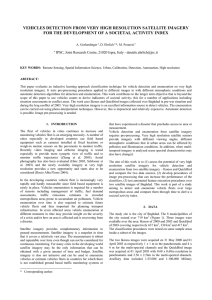COMPARISON OF MULTI-SCALE IMAGES OF AN AGRICULTURAL LAND USING
advertisement
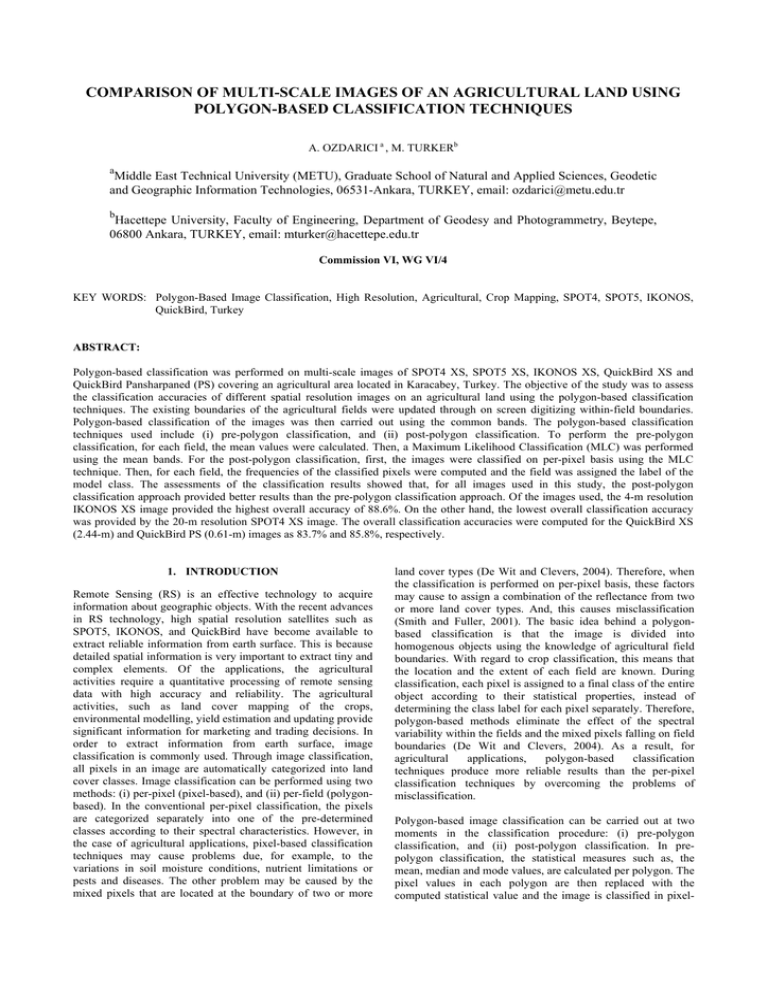
COMPARISON OF MULTI-SCALE IMAGES OF AN AGRICULTURAL LAND USING POLYGON-BASED CLASSIFICATION TECHNIQUES A. OZDARICI a , M. TURKERb a Middle East Technical University (METU), Graduate School of Natural and Applied Sciences, Geodetic and Geographic Information Technologies, 06531-Ankara, TURKEY, email: ozdarici@metu.edu.tr b Hacettepe University, Faculty of Engineering, Department of Geodesy and Photogrammetry, Beytepe, 06800 Ankara, TURKEY, email: mturker@hacettepe.edu.tr Commission VI, WG VI/4 KEY WORDS: Polygon-Based Image Classification, High Resolution, Agricultural, Crop Mapping, SPOT4, SPOT5, IKONOS, QuickBird, Turkey ABSTRACT: Polygon-based classification was performed on multi-scale images of SPOT4 XS, SPOT5 XS, IKONOS XS, QuickBird XS and QuickBird Pansharpaned (PS) covering an agricultural area located in Karacabey, Turkey. The objective of the study was to assess the classification accuracies of different spatial resolution images on an agricultural land using the polygon-based classification techniques. The existing boundaries of the agricultural fields were updated through on screen digitizing within-field boundaries. Polygon-based classification of the images was then carried out using the common bands. The polygon-based classification techniques used include (i) pre-polygon classification, and (ii) post-polygon classification. To perform the pre-polygon classification, for each field, the mean values were calculated. Then, a Maximum Likelihood Classification (MLC) was performed using the mean bands. For the post-polygon classification, first, the images were classified on per-pixel basis using the MLC technique. Then, for each field, the frequencies of the classified pixels were computed and the field was assigned the label of the model class. The assessments of the classification results showed that, for all images used in this study, the post-polygon classification approach provided better results than the pre-polygon classification approach. Of the images used, the 4-m resolution IKONOS XS image provided the highest overall accuracy of 88.6%. On the other hand, the lowest overall classification accuracy was provided by the 20-m resolution SPOT4 XS image. The overall classification accuracies were computed for the QuickBird XS (2.44-m) and QuickBird PS (0.61-m) images as 83.7% and 85.8%, respectively. 1. INTRODUCTION Remote Sensing (RS) is an effective technology to acquire information about geographic objects. With the recent advances in RS technology, high spatial resolution satellites such as SPOT5, IKONOS, and QuickBird have become available to extract reliable information from earth surface. This is because detailed spatial information is very important to extract tiny and complex elements. Of the applications, the agricultural activities require a quantitative processing of remote sensing data with high accuracy and reliability. The agricultural activities, such as land cover mapping of the crops, environmental modelling, yield estimation and updating provide significant information for marketing and trading decisions. In order to extract information from earth surface, image classification is commonly used. Through image classification, all pixels in an image are automatically categorized into land cover classes. Image classification can be performed using two methods: (i) per-pixel (pixel-based), and (ii) per-field (polygonbased). In the conventional per-pixel classification, the pixels are categorized separately into one of the pre-determined classes according to their spectral characteristics. However, in the case of agricultural applications, pixel-based classification techniques may cause problems due, for example, to the variations in soil moisture conditions, nutrient limitations or pests and diseases. The other problem may be caused by the mixed pixels that are located at the boundary of two or more land cover types (De Wit and Clevers, 2004). Therefore, when the classification is performed on per-pixel basis, these factors may cause to assign a combination of the reflectance from two or more land cover types. And, this causes misclassification (Smith and Fuller, 2001). The basic idea behind a polygonbased classification is that the image is divided into homogenous objects using the knowledge of agricultural field boundaries. With regard to crop classification, this means that the location and the extent of each field are known. During classification, each pixel is assigned to a final class of the entire object according to their statistical properties, instead of determining the class label for each pixel separately. Therefore, polygon-based methods eliminate the effect of the spectral variability within the fields and the mixed pixels falling on field boundaries (De Wit and Clevers, 2004). As a result, for agricultural applications, polygon-based classification techniques produce more reliable results than the per-pixel classification techniques by overcoming the problems of misclassification. Polygon-based image classification can be carried out at two moments in the classification procedure: (i) pre-polygon classification, and (ii) post-polygon classification. In prepolygon classification, the statistical measures such as, the mean, median and mode values, are calculated per polygon. The pixel values in each polygon are then replaced with the computed statistical value and the image is classified in pixel- based manner. In post-polygon classification, first, a per-pixel classification is carried out. Then, for each polygon, the frequency of the classified pixels is computed and the majority pixel is assigned as the label to the polygon. The objective of this study is to compare the classification accuracies of multi-scale, uni-temporal images on an agricultural land using the polygon-based image classification techniques. To apply the concept and evaluate the results, a study area was selected from the ‘Karacabey Plain’ in northwest of Turkey. The methodology was applied using the common bands (green, red, near-infrared) of five satellite images that are SPOT4 XS (20m), SPOT5 XS (10m), IKONOS XS (4m), Quickbird XS (2,44m) and QuickBird Pansharpaned (0,61m). First, the preprocessing operations that include updating the vector data, data fusion, and geometric corrections were carried out. After the preprocessing operations, the prepolygon classification of the images was carried out. To do that, first, the vector and raster data were integrated and the mean values were calculated for each agriculture field. Then, the MLC was performed on each image. For the post-polygon classification, first, the per-pixel MLC was carried out. Then, for each field, the frequency of the classified pixels was computed and the field was assigned the label of the model class. A database was utilized to invoke the queries effectively for assessing the results. Finally, the classified images were compared and assessed using the reference data. 2. STUDY AREA AND DATA DESCRIPTION The selected area of study is located in Marmara region near Karacabey, Bursa in northwest of Turkey (Figure 1). The area is situated between the latitudes 4 444 750.00 N to 4 453 500.00 N and longtitudes 610 750.00 E to 599 850.00 E. It covers an area of approximately 95 km2. This area is representative of the agricultural structure and is characterized by rich, loamy soils and combines with good wheather conditions. Due to these characteristics, it is one of the most valuable agricultural regions of Turkey. There are multiple crop types with multiple growing seasons in the area. The main crops cultivated in the area are tomato, corn, pepper, wheat, sugarbeet and rice. Figure 1. The Study Area The polygon-based classification techniques require vector data to be integrated with the raster data. The vector data used in this study was produced for a previous graduate study conducted in the department of Geodetic and Geographic Information Technologies at Middle East Technical University (Arikan, 2003). The existing vector data consist of cadastral maps, which contain the agricultural field boundaries. Five different satellite images were used to apply the techniques of polygon-based classification. These are SPOT4 XS (23 July 2004), SPOT5 XS (22 July 2004), IKONOS XS (15 July 2004), and QuickBird Bundle (13 August 2004) image. As can be seen from the acquisition dates of the images, it was tried to work with uni-temporal images. However, it was not possible to acquire the images in a specific day due to the usage of different sensor types and weather conditions. Therefore, the acquisition dates of the images were kept as close as possible to each other. Each scene was collected at good weather conditions, cloud free and of good quality. Therefore, there was no effect for limiting the usefulness of the images. The images were geocoded to Universal Transverse Mercator (UTM) coordinate system. While the preprocessing level of SPOT and QuickBird images was level 2A, the level of IKONOS image was standard geometrically corrected. At these processing levels, the radiometric correction is made to compensate the distortions due to differences in the viewing conditions. The geometric correction is also applied on the images in a standard cartographic projection (UTM WGS 84) without using ground control points at ground receiving stations. Technical characteristics of each image are given in table 1. Table 1. The technical characteristics of the images Processing L. Image Type Datum Map Projection Zone Number SPOT IKONOS QUICKBIRD Level 2A Multispectral WGS 84 UTM 35 Std.Geo.Corrt. Multispectral WGS 84 UTM 35 Level 2A Bundle WGS 84 UTM 35 Of the images used, SPOT4 XS image has 20-m resolution and has four bands that are green (G), red (R), near-infrared (NIR) and short wave infrared (SWIR). The area is covered by 556 x 461 pixels. The spatial resolution of the SPOT5 XS image is 10 m in the visible and NIR bands, while it is 20 m for the SWIR band. The size of the SPOT5 image used was 1120 pixels and 929 lines. The IKONOS XS image has 4-m spatial resolution. It contains four multispectral bands that are blue B, G, R, and NIR. The size of the IKONOS image used was 2771 pixels and 2324 lines. The QuickBird Bundle standard product was also used in this study. The bundle product means that the panchromatic (PAN) and multispectral (XS) images are commerced together. The spatial resolutions of the QuickBird PAN and QuickBird XS images are 0.61m and 2.44m, respectively. The QuickBird images contain four multispectral bands (B, G, R, and NIR) and a panchromatic band. The sizes of the QuickBird images used were 19026x15948 for the panchromatic band, and 4666 x 3873 for the multispectral bands (Manual of Photogrammetry). The spatial resolutions of the images used are given in figure 2. Then, the other preprocessing steps were carried out. These include image mosaicing, image fusion, image-to-map and image-to-image geometric corrections. Image mosaicing was applied on the QuickBird XS and QuickBird PAN images by means of merging six sub-images using the OrthoEngine module of the PCI Geomatica software v. 9.1.5. In order to examine more detailed crop information, the QuickBird multispectral bands and the QuickBird PAN band were merged. The merged image retains the spatial resolution of the panchromatic band, yet provides the spectral properties of multispectral bands. Figure 2. The spatial resolutions of the images 3. IMAGE COLLECTION AND PREPROCESSINGS The vector data was prepared by cutting it based on the sizes of the raster data sets. Then, a manual on screen digitizing method was used to extract within field dynamic crop boundaries. The digitization process was carried out using the colour composite of NIR, R, and G bands of the QuickBird image. The digitized vector data is illustrated in figure 3. 28017’18’’E 40022’87’’N 28030’18’’E 40014’35’’N Figure 3. The digitized agricultural field boundaries. After completing the digitization process, it was observed that the number of fields increased from 3401 to 4134. Besides the large fields, a significant number of small fields were also observed during the digitization process. The number of fields and the field sizes are illustrated in figure 4. 1200 Although the images were acquired at different dates and sensor locations no additional radiometric or atmospheric corrections were carried out on the images. The first reason is that the sun elevation and the azimuth angles of the images were not significantly different. The azimuth angles of the SPOT4, SPOT5, IKONOS, and QuickBird images were 134,600, 131,080, 133,170, and 141,600, respectively. On the other hand, their sun elevation angles were 64,00, 63,050, 65,310, and 59,600, respectively. The second reason is that the aim of this study was to separate the classes from each other through image classification. Therefore, radiometrically or atmospherically corrected image values do not dramatically affect the results (Janssen, 2005). All the image data sets were georectified by locating the ground control points (GCPs) on the images and by applying a secondorder polynomial and the nearest neighbour resampling method. The polygon boundary data set was used as the reference source. The GCPs were selected from distinct features, such as the intersections of the roads and sharp boundaries of the parcels. First, the QuickBird PS image was geometrically corrected based on the polygon boundary data. To do that 12 GCPs were selected from the same locations on both vector and raster data sets. Then, the other images were registered based on the corrected QuickBird PS image. To perform these corrections, 20 GCPs were selected from the same locations on each image. After performing the geometric correction processes, it was observed that the results of the corrections were quite satisfactory to apply the polygon-based classification procedure. For each image, the resulting Root Mean Square (RMS) errors are illustrated in table 2. Table 2. The RMS errors for the geometric corrections of the images. Data Number of GCPs Polynomial Resamplin g RMSE (pixels) SPOT4 XS SPOT5 XS IKONOS XS QuickBird XS QuickBird PS 20 20 20 20 12 2nd 2nd 2nd 2nd 2nd NN NN NN NN NN ± 0.40 ± 0.41 ± 0.40 ± 0.40 ± 0.80 800 4. THE METHODOLOGY 600 400 4.1 Selection of the Training Areas 200 9, 5 9- Parcel Area (ha) Figure 4. The size of the polygons 10 .42 7, 5 6, 5 8, 5 8- 7- 6- 4, 5 3, 5 2, 5 5, 5 5- 4- 3- 1, 5 1- 2- 0, 5 0 0- Number of Parcels 1000 A great effort was spent during the training area selection since the training areas were collected from the most represented homogenous areas. The crop types selected to perform the classification process include Corn (Cr), Residue (Rs), Sugarbeet (Sb), Rice (Rc), Tomato (Tm), and Pepper (Pp). The selected classes were separated into subclassess to avoid defining pixel variability within the training sets. They were characterized as two types of Rs, three types of Cr, two types of Sb, two types of Tm, and two types of Pp. It was observed that the spectral characteristics of the crops tomato and pepper were quite similar. Therefore, these crops were aggregated and the resulting class was named as Tm/Pp. In addition to the spectral differences, the phenological characteristics of the crops were also taken into account during the selection of the training areas. The phenological characteristics of the crops are given in figure 5 (Turker and Arikan, 2005). used as the inputs for performing the per-pixel maximum likelihood classifier. The steps of the pre-polygon classification are given in figure 7. GIS Polygon Boundaries Training Data Image Data Calculated mean digital number perobject MLC Determine label per-polygon Bare Soil Sparse Vegetation Dense Vegetation Accuracy Assessment Figure 5. The phenological characteristics of the crops The training areas were selected from 4m resolution IKONOS XS image since the IKONOS image appears to be optimum for the visual selection procedure when compared with the other images. The false colour composite of the bands 4 (NIR), 3 (R), and 2 (G) was used when selecting the training samples. This is because the healthy vegetation absorbs most of the green and red incident energy and reflects almost half of the incident NIR energy. Hence, the green vegetation shows up in shades of red. The colour composite of the IKONOS image bands with the agricultural polygon boundaries overlaid is shown in figure 6. 28017’18’’E 40022’87’’N Results Figure 7. The pre-polygon classification 4.3 Post-Polygon Classification The methodology of the post-polygon classification is illustrated in figure 8. In order to carry out the post-polygon classification, first, a per-pixel MLC was performed. Then, the vector data was overlaid on the classified image and, for each field, the frequencies of the pixels were computed and the dominant class was assigned to the polygon as the class label of that polygon. GIS Polygon Boundaries Image Data Training Data MLC 28030’18’’E 40014’35’’N Label per-pixel Figure 6. A color composite of the IKONOS image 4.2 Pre-Polygon Classification In pre-polygon image classification, the statistical measures such as, mean, median and mode are calculated per-polygon and, a unique spectral value is assigned to each field. In this study, the mean values were used as the statistical measure. To apply this technique, the new bands that contain the mean values were generated for the common bands of green (G), red (R), and (NIR) of the images. The purpose of computing the mean values in each agricultural polygon was to assign a unique grey level to each polygon. Next, the generated new bands were Determine label per-polygon Accuracy Assessment Results Figure 8. The method of post-polygon classification Table 4. The classification accuracies of the post-polygon classification 5. RESULTS AND DISCUSSION The results of pre-polygon classification were evaluated using the measures of the classification accuracy based on the confusion matrix (Table 3), which contains the individual and overall accuracies of each image. The QuickBird PS and IKONOS XS images provided the highest overall accuracies of 82.1% and 81.8% and the overall kappa of 74% and 74.2%, respectively. The accuracies of these images were followed by the QuickBird XS image, for which the overall accuracy and overall kappa were computed to be 78.6% and 68.6%, respectively. The 10-m resolution SPOT5 XS image provided an overall accuracy of 69.8% and an overall kappa of 56.5%. The lowest results were obtained for the SPOT4 XS image, which has the lowest spatial resolution. For this image, the overall accuracy and overall kappa were computed to be 65.2% and 50.8%, respectively. When the individual class accuracies were examined, it was observed that Rs had the highest results of about 90% for the IKONOS XS, QuickBird XS, and QuickBird PS images, while the lowest acquracies of about 40% were obtained for class Rc. Table 3. The classification accuracies of the pre-polygon classification using the mean values SPOT4 SPOT5 IKONOS OA OK OA OK OA OK QuickBird XS OA OK QuickBird PS OA OK 65,2 50,8 69,8 56,5 81,8 74,2 78,6 68,6 82,1 74 PA UA PA UA PA UA PA UA PA UA Rs 56,3 96,3 72,8 97,1 84,9 97,9 93,2 89,1 94,8 90,1 Sb 81 36,1 81 56,6 97,2 69,2 43,2 64 54 68,9 Rc 13,7 100 62 60 65,5 82,6 27,5 53,3 34,4 27 Cr 78,2 69 45 75,1 77 76,2 62,4 91,5 71,9 89,5 Tm /Pp 66,4 54,1 84,4 57,3 82,2 75,5 94,1 69,7 91,7 79 PA: Producer’s Accuracy (%), UA: User’s Accuracy (%), OA: Overall Accuracy (%), OK: Overall Kappa (%) In post-polygon classification, the highest accuracies were obtained for the IKONOS image. The overall accuracy and overall kappa were computed to be 88.6% and 83.7%, respectively. The accuracies computed for the QuickBird XS and QuickBird PS images were also similar. The overall accuracies of these images were about 85% and the overall kappa were computed to be approximately 77%. When the confusion matrix was computed for the SPOT5 XS image, a decrease of about 4% was observed. Similar to the pre-polygon classification, the lowest overall accuracy of 76.1% and overall kappa of 65.7% were obtained for the SPOT4 XS image. Of the individual classes, Rs provided the highest producer’s and user’s accuracies of about 95% while the lowest accuracies of 45% were obtained for Rc. SPOT4 SPOT5 IKONOS OA OK OA OK OA OK QuickBird XS OA OK QuickBird PS OA OK 76,1 65,7 81,4 73,3 88,6 83,7 83,7 77,0 85,8 79,9 UA PA UA PA UA PA UA PA UA PA Rs 83,4 97,5 84,6 97,5 90 97,3 96,3 87,3 96,3 86,1 Sb 78,3 48,3 81 63,8 100 75,5 91,8 66,6 89,1 64,7 Rc 72,4 63,6 72,4 67,7 79,3 85,1 58,6 30,3 58,6 29,8 Cr 48,8 88,8 59,9 94 78,6 91,9 68,7 94,8 75,1 95,5 Tm /Pp 89,1 64,4 95 70,2 94,1 82,1 92,5 84,5 92,2 89,7 The overall and individual class accuracies are given in table 4. As can be seen in the table, the accuracies of post-polygon classification are slightly higher than pre-polygon classification. The main reason for this would be that due to large variations within the fields the statistical values calculated for each field may not represent the actual crop information within the fields. It was revealed in the past studies that the classification accuracy is often inversely related to spatial resolution. In the present case, on the contrary to this general concept, a decrease in pixel size resulted in an increase in the classification accuracies. The IKONOS XS image provided the highest accuracies of about 85%, which was followed by the QuickBird images with the accuracies of about 80%. The lowest accuracies were obtained for the SPOT4 XS image with about 65%. One reason for this would be the effect of training pixels. It should be borne in mind that when selecting the training areas for the SPOT and QuickBird images the training areas were transferred from the 4-m resolution IKONOS image so that the results should be compared accurately. Therefore, the classifications were carried out by using the samples collected from the same locations of the images. However, this was not quite possible due to the differences in the spatial resolutions of the images used. Depending on the spatial resolution of the images used the number of training pixels changed. For example, the training pixels dramatically decreased for the SPOT4 XS and SPOT5 XS images. This might have resulted in low classification accuracies for these images. The other reason would be the effect of small fields in the study area. It was observed that for the high spatial resolution images higher number of pixels fall within the fields and therefore, the small fields are better classified using the high resolution images. For the post-polygon classification, the inclusion of the blue and SWIR bands did not improve the accuracies significantly. The main reason for this would be the acquisition dates of the images. In the days the images were collected, the blue and SWIR bands might not have been effective to differentiate the selected crop types. When the results of both the pre- and post-classifications were examined it was observed that the class Rs had the highest producer’s and user’s accuracies. This is due to the fact that Rs represented distinct spectral response pattern. This is because in the dates the images were acquired Rs was already harvested. The other reason would be that the size of Rs fields are quite large when compared with the other crop types. On the other hand, a higher number of pixels fall within larger fields when compared with the small sized fields. Therefore, this may correctly increase the chance of the classification. The class Rc exhibited the lowest accuracies for the QuickBird XS and QuickBird PS images. This may be due to the acquisition dates of the QuickBird images. The QuickBird images were recorded ten days after the acquisition of the other images. During the acquisition of the IKONOS XS, SPOT4 XS and SPOT5 XS images the Rc fields still contained water. However, ten days later the Rc fields might have been covered by the green leaves of the rice class. Therefore, this might have negative effects on both the quality of the training areas and the accuracy of the class Rc. When the accuracies were examined with respect to the prices of the satellite images used it was observed that a question of cost effectiveness raises, especially for image users to buy images under a fixed budget. A summary of the prices and the overall classification accuracies are given in table 5. As can be seen in the table, the cheapest of the four images used is SPOT4 XS, which has the cost of US$ 0,90km2. The SPOT4 XS imagery appears to be cost effective for crop mapping. However, it provides an overall accuracy in the range of 65% and 76% for the pre-polygon and post-polygon classifications, respectively. Although the SPOT5 XS image was more than six times as expensive as the SPOT4 XS image, it provided about 5% better accuracy than the SPOT4 XS image. The IKONOS XS image exhibited a significant difference in the price when compared with the SPOT images. Although the best results were provided by the IKONOS XS image, it was more than five times as expensive as the SPOT5 XS image and more than five times as expensive as the SPOT 4 image. The most expensive image used in this study was the QuickBird imagery. The cost of the QuickBird Bundle image was US$ 32.00 km2. Although the price of the QuickBird Bundle image is high it provided the second highest classification accuracies for both pre-polygon and post-polygon classification. More studies to be applied on different locations that represent a variety of land cover types may better answer the questions about the cost effectiveness of the satellite images. The results obtained in this study showed that the polygonbased classification improves the accuracies by means of classifying the homogenous fields. Therefore, it can be stated that by using a polygon-based approach the crop mapping of the agricultural fields can be carried out more reliably when compared with the traditional per-pixel classification techniques. Acknowledgement The authors are greatful to State Planning Organization (DPT) of Turkey for supporting this project. References Arikan, M., 2003, A multitemporal masking classification method for field-based agricultural crop mapping. Thesis in Geodetic and Geographic Information Technologies, Middle East Technical University, Ankara, Turkey. De Wit A. J. W., and Clevers J. G. P. W., 2004. Efficiency and accuracy of per-field classification for operational crop mapping. International Journal of Remote Sensing. 68(11), pp. 1155-1161. Janssen J., 2005. Introductory to Digital Image Processing: A Remote Sensing Perspective, Prantice Hall, United States of America, pp. 198-199. Lillesand T. M., Kiefer R. W. and Chipman J. W., 2004. Remote Sensing and Image Interpretation. Wiley, United States of America, pp. 552-572. Manual of photogrammetry, Fifth Edition, 2004. Smith G. M. and Fuller R.M., 2001. An integrated approach to land cover classification: an example in the Island of Jersey. International Journal of Remote Sensing, 22(16), pp. 31233142. Table 5. The costs and the overall accuracies of the images Price/km2 Pre-Polygon Classification Post-Polygon Classification SPOT4 0.90 65,2 (%) 76,1 (%) SPOT5 5.50 69,8 (%) 81,4 (%) IKONOS 28.00 81,8 (%) 88,6 (%) QuickBird XS 31.00 78,6 (%) 83,7 (%) QuickBird PS 32.00 82,1 (%) 85,8 (%) 6. CONCLUSIONS In this study, pre-polygon and post-polygon classification techniques were carried out using the SPOT4 XS, SPOT5 XS, IKONOS XS, QuickBird XS and QuickBird PS images covering an agricultural area. The results of the post-polygon classification were found to be higher than the pre-polygon classification. The IKONOS XS and QuickBird (XS and PS) images provided better overall accuracies (about 85%) than the other images. On the other hand, the lowest accuracies were computed to be approximately 70% for the SPOT4 XS image, which has the lowest spatial resolution of the images used in this study. The SPOT5 XS image provided the overall accuracy of 81,4%. Turker M. and Arikan M., 2005. Sequential masking classification of multi-temporal Landsat7 ETM+ images for field-based crop mapping in Karacabey, Turkey. International Journal of remote Sensing, Vol. 26, No. 17, pp. 3813-3830.
